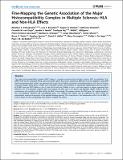| dc.contributor.author | Patsopoulos, Nikolaos A. | |
| dc.contributor.author | Barcellos, Lisa F. | |
| dc.contributor.author | Hintzen, Rogier Q. | |
| dc.contributor.author | Schaefer, Catherine | |
| dc.contributor.author | van Duijn, Cornelia M. | |
| dc.contributor.author | Noble, Janelle A. | |
| dc.contributor.author | Raj, Towfique | |
| dc.contributor.author | Gourraud, Pierre-Antoine | |
| dc.contributor.author | Stranger, Barbara E. | |
| dc.contributor.author | Oksenberg, Jorge | |
| dc.contributor.author | Olsson, Tomas | |
| dc.contributor.author | Taylor, Bruce V. | |
| dc.contributor.author | Sawcer, Stephen | |
| dc.contributor.author | Hafler, David A. | |
| dc.contributor.author | Carrington, Mary | |
| dc.contributor.author | De Jager, Philip L. | |
| dc.contributor.author | de Bakker, Paul I. W. | |
| dc.date.accessioned | 2013-12-30T20:34:50Z | |
| dc.date.available | 2013-12-30T20:34:50Z | |
| dc.date.issued | 2013-11 | |
| dc.date.submitted | 2013-04 | |
| dc.identifier.issn | 1553-7404 | |
| dc.identifier.issn | 1553-7390 | |
| dc.identifier.uri | http://hdl.handle.net/1721.1/83401 | |
| dc.description.abstract | The major histocompatibility complex (MHC) region is strongly associated with multiple sclerosis (MS) susceptibility. HLA-DRB1*15:01 has the strongest effect, and several other alleles have been reported at different levels of validation. Using SNP data from genome-wide studies, we imputed and tested classical alleles and amino acid polymorphisms in 8 classical human leukocyte antigen (HLA) genes in 5,091 cases and 9,595 controls. We identified 11 statistically independent effects overall: 6 HLA-DRB1 and one DPB1 alleles in class II, one HLA-A and two B alleles in class I, and one signal in a region spanning from MICB to LST1. This genomic segment does not contain any HLA class I or II genes and provides robust evidence for the involvement of a non-HLA risk allele within the MHC. Interestingly, this region contains the TNF gene, the cognate ligand of the well-validated TNFRSF1A MS susceptibility gene. The classical HLA effects can be explained to some extent by polymorphic amino acid positions in the peptide-binding grooves. This study dissects the independent effects in the MHC, a critical region for MS susceptibility that harbors multiple risk alleles. | en_US |
| dc.description.sponsorship | R01NS049477 | en_US |
| dc.description.sponsorship | R01NS026799 | en_US |
| dc.description.sponsorship | NIH/NINDS R01NS049510 | en_US |
| dc.description.sponsorship | R01NS0495103 | en_US |
| dc.description.sponsorship | NIH/NIAID R01AI076544 | en_US |
| dc.language.iso | en_US | |
| dc.publisher | Public Library of Science | en_US |
| dc.relation.isversionof | http://dx.doi.org/10.1371/journal.pgen.1003926 | en_US |
| dc.rights.uri | http://creativecommons.org/licenses/by/2.5/ | en_US |
| dc.source | PLoS | en_US |
| dc.title | Fine-Mapping the Genetic Association of the Major Histocompatibility Complex in Multiple Sclerosis: HLA and Non-HLA Effects | en_US |
| dc.type | Article | en_US |
| dc.identifier.citation | Patsopoulos, Nikolaos A., Lisa F. Barcellos, Rogier Q. Hintzen, Catherine Schaefer, Cornelia M. van Duijn, Janelle A. Noble, Towfique Raj, et al. “Fine-Mapping the Genetic Association of the Major Histocompatibility Complex in Multiple Sclerosis: HLA and Non-HLA Effects.” Edited by Greg Gibson. PLoS Genetics 9, no. 11 (November 21, 2013): e1003926. | en_US |
| dc.contributor.department | Harvard University--MIT Division of Health Sciences and Technology | en_US |
| dc.contributor.mitauthor | Hafler, David A. | en_US |
| dc.relation.journal | PLoS Genetics | en_US |
| dc.eprint.version | Final published version | en_US |
| dc.type.uri | http://purl.org/eprint/type/JournalArticle | en_US |
| eprint.status | http://purl.org/eprint/status/PeerReviewed | en_US |
| dspace.orderedauthors | Patsopoulos, Nikolaos A.; Barcellos, Lisa F.; Hintzen, Rogier Q.; Schaefer, Catherine; van Duijn, Cornelia M.; Noble, Janelle A.; Raj, Towfique; Gourraud, Pierre-Antoine; Stranger, Barbara E.; Oksenberg, Jorge; Olsson, Tomas; Taylor, Bruce V.; Sawcer, Stephen; Hafler, David A.; Carrington, Mary; De Jager, Philip L.; de Bakker, Paul I. W. | en_US |
| mit.license | PUBLISHER_CC | en_US |
| mit.metadata.status | Complete | |

